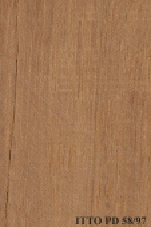
TROMPILLO (Guarea guidonia)
Trade Name
Trompillo
Scientific Name
Guarea guidonia (L.) Sleumer
Family
MELIACEAE
Common Names
Trompillo (Bolivia); Cachimbo (Venezuela); Trompillo (Venezuela); Lapati Caspi (Peru); Yantso (Ecuador); Yantsau (Ecuador); Yantsan (Ecuador); Shuina (Ecuador); Villo Villo (Ecuador); Congui`ocho (Ecuador); Tucuta (Ecuador); Cedrillo (Ecuador); Tocota (Ecuador); Sambo Cedro (Colombia); Pialde (Colombia); Requia (Colombia); Piaste (Ecuador); Pico Del Oro; Guaraguao; Guano Blanco; Gitó (Brazil); Fruta De Loro; Cramantree; Cedrophy; Requia (Peru); Carrapeteiro (Brazil); Atauba (Brazil); Trompito; Cramantee; Peito De Pomba (Brazil); Cedrillo Blanco; Cambotata; Acajou; Ata Blanco; Alligator Wood; Wild Akee; Muskwood; American Muskwood; Zambo Cedro (Colombia); Carimbo; Pulgande
Scientific Name Synonyms
Samyda guidonia L.; Guarea trichilioides L.; Guarea puberula Pittier; Guarea multiflora A. Juss.; Guarea aubletii A. Juss.; Guarea alternans C. DC.; Guarea alba C. DC.
Description Of The Tree
Botanical Description
This species is reported to be a medium size tree, with heights between 15 to 20 m, up to 25 m. The diameter at breast height is commonly from 40 to 60 cm, or even up to 90 cm. The bole is straight, with small buttresses.
Natural Habitat
Guarea guidonia is a typical species from gallery forests. It is found in secondary forests, along water courses and alluvial sites. Rarely reported in primary forests.
Natural Distribution
This species is reported to be distributed in the tropical and subtropical forests of Central and South America. In Brazil it is found in until Rio de Janeiro , Sao Paulo and Mato Grosso do Sul. It is also common in the Parana basin.
Wood Identification
Anatomic Description Of Wood
Wood diffuse porous. Vessels solitary and in short radial multiples. Tangential diameter of vessel lumina 150 to 200 micras (medium). Vessels per mm2 10 to 20 (abundant). Occasionally vessels per mm2 less than 6. Simple perforation plates. Vessel-ray pits simil Axial parenchyma confluent. Axial parenchyma oblique and/or sinuous. Prismatic crystals in chambered axial parenchyma cells and/or in fibers. 5 to 8 cells per parenchyma strand. Rays exclusively uniseriate. Silica bodies in the ray cells. Homogeneous rays and/or sub-homogeneous rays (all ray cells procumbent). Septate fibers present. Fibers with simple to minutely bordered pits.
-
 Wood Macro Photo Tangential Plane
Wood Macro Photo Tangential Plane
Availability
Cites Status
Unrestricted
General Wood Description
Odor
It has a pleasant smell.
Color
The sapwood is differentiated, it is pale brown, the heartwood is light red when dry.
COLOR INDEX (1=Black, 7=Light yellow,white)
4
Grain
The grain is mostly straight
Texture
Texture is usually medium to coarse.
Luster
It is reported to be moderate in luster.
Natural durability index (1= Very high durability, 7=Vey low durability)
3
Resistance To Impregnation
This timber responds poorly to preservative treatment.
Wood Physical Properties
Basic Density or Specific Gravity (O.D. weight/vol. green) (g/cm³)
0.48
Air-dry Density (Weight and volume at 12%MC) (g/cm³)
0.52
Total shrinkage Tangential (Saturated to 0%MC) (%)
6.3
Total shrinkage Radial (Saturated to 0%MC) (%)
3.2
Drying Defects
Ease of Drying: Drying is rated as rapid. Drying Defects: Slight tendency to checking and cupping. Severe casehardening is also reported.
Recommended Dry Kiln Schedule
UK-E; US-T6-D2
Dimensional stability ratio (Total Tangential Shrinkage %/Total Radial Shrinkage %)
2.0
Wood Chemical Properties
Wood Mechanical Properties
Bending Strength (MOR),12%MC (kgf/cm²)
682
Stiffness (MOE) 12%MC (kgf/cm²)
113000
Compression parallel to fiber 12%MC (kgf/cm²)
442
Compression perpendicular to fiber 12%MC (kgf/cm²)
58
Shear strength radial 12%MC (kgf/cm²)
61
Janka hardness (side) 12%MC (kgf)
399
Janka hardness (end grain) 12%MC (kgf)
490
Workability
Sawing
Sawmilling of this species is reportedly easy.
Machining
Machining of this species is reported to be easy.
Planing
Planing operations are rather easy.
Turning
30
Boring
Boring operations are reported to be fair.
Nailing
Nailing properties are good.
Sanding
It is easy to sand.
Finishing
It has a good finishing.
Coatings
It paints and varnishes well.
Polishing
This species is reported to be easy to polish.
Substitute Species
Swietenia sp.
REFERENCED USES
End Uses Summary
HOUSING GENERAL, fittings, shutter boards, FURNITURE AND CABINETS, PLYWOOD AND VENEER, TURNING, SPORTS, table tennis, PACKING, CONTAINERS, truck bodies, NAVAL CONSTRUCTION, OTHER AND MUSICAL INSTRUMENTS, handicrafts
General Housing
- 10 - Silica in Timbers
Fittings
- 19 - Silica in Timbers
Shutter Boards
- 20 - Prospect: The wood database
Furniture Cabinets
- 21 - Tropical timbers of the world. Part III-Southeast Asian and Oceanian Species.
Panels, Veneers
- 25 - Directory of Timber Trade Malaysia
Turning
- 30 - Embassy of Honduras in Japan
Sports
- 38 - Annual Review and Assessment of the World Timber Situation 1998-ITTO
- 41 - Embassy of the Philippines
Packing
- 45 - Recopilación y Análisis de Estudios Tecnológicos de Maderas Peruanas
Truck Body
- 53 - Timbers of the New World
Shipbuilding
- 55 - Tropical Timber Atlas of Latin America
Handcraft
- 66 - Maderas latinoamericanas. VII. Caracteristicas anatomicas. propiedades fisicomecanicas, de secado, y tratabilidad de la madera juvenil de Cordia alliodora (Ruiz & Pav. Oken.)
Please Provide Information To View Producer Information